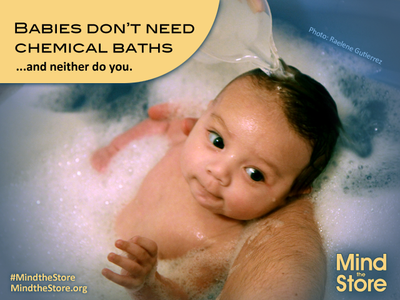Our latest Times Square ad says it all: Babies don’t need chemical baths, and neither do you.
It’s part of a several week public service announcement in the heart of Times Square. Just above ground level, our ads have sent a message to millions of Times Square shoppers: beware of toxic chemicals in your products and ask retailers to Mind the Store.
Unfortunately, toxic chemicals are commonly found in the products we use everyday, including bath products, children’s lotions, and shampoos. Due to our lax federal laws on chemicals and cosmetics, it’s the Wild West when it comes to the ingredients in our products. Anything goes.
Chemicals in bath and personal care products
(Click on the links below for consumer tips and action steps on these chemicals)
- Parabens: A hormone-disrupting chemical that is used in personal care products as a preservative
- Triclosan: A pesticide used in anti-bacterial soaps, hand sanitizers and other products
- Phthalates: A class of toxic chemicals commonly used in fragrances, personal care products and cosmetics
- Formaldehyde and formaldehyde releasing preservatives: Found in the bath products, lotions and other products
The big-picture “chemical bath”
Researchers and scientists have found that not only are we exposed to toxic chemicals in everyday bath products, we encounter them throughout our day.
- A study from researchers at the University of California—San Francisco, found that virtually all U.S. pregnant women carry multiple chemicals, including some banned since the 1970s and others used in common products, such as non-stick cookware, food and beverage cans, and personal care products.
- Dr. Greene, a well-respected pediatrician, responded to the CDC data by stating, “The developing fetus is uniquely vulnerable and impacts during this phase of rapid development can potentially be irreversible and life-altering.”
- In U.S. girls, puberty is beginning earlier than in the past. A weight-of-the-evidence evaluation of human and animal studies suggests that endocrine-disrupting chemicals, particularly estrogen mimics and anti-androgens, as well as increased body fat and certain social circumstances, can advance the onset of puberty.
- The CDC has published data showing that exposures to endocrine-disrupting chemicals like phthalates, bisphenol A (BPA), perfluorinated compounds, and cadmium are common. The CDC reports that almost everyone has these chemicals in their bodies, some at levels near or above those shown in scientific studies to cause adverse effects on reproductive health.
Even as I type these words it’s hard to process the enormity of the problem before us. We need to make some drastic movements to comprehensively tackle toxic chemicals. We’ve made progress—don’t get me wrong, but we need to transition from baby steps on toxic chemicals to larger scale solutions.
We’re tackling this issue from two directions; we’re asking Congress to pass strong laws on toxic chemicals, since this ultimately needs to be solved with a functioning federal system. Although Congress is seeing some momentum on reforming our federal laws, we need progress in the marketplace.
Our second, and equally important solution is through our Mind the Store campaign. We’re asking the nation’s top ten retailers to get serious about toxic chemicals in the supply chain. Is it a big ask of the retailers? Yes, but big problems require big solutions.
Join the movement NOW. We need you.
Share this image and blog on Facebook!




